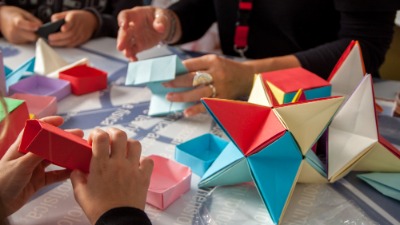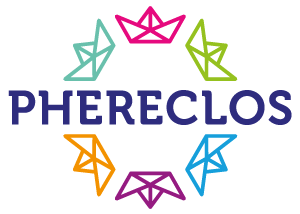SISSA FOR SCHOOLS
- Italy,Trieste - Friuli Venezia Giulia region
- 2013

| Time frame | |
| Categories | |
| Level of Schools | |
| External Partners | |
| Type of Schools | |
| URL | |
| Number of Schools involved | |
| Number of Schoolheads involved | |
| Number of Teachers involved | |
| Number of Students involved | |
| Number of Parents involved | |
| Number of External Partners involved |
“SISSA FOR SCHOOLS” is the program of visits offered by the International School for Advanced Studies (SISSA, Trieste, Italy), including interactive activities related to the institution’s research areas. Dedicated to pupils from primary until high schools, it is annually organized every Thursday from October to May. Each visit is composed of three parts: a presentation of the institution, interactive activities with young scientists and a tour of the institution facilities.
Show science as a vital, useful, beautiful human activity, made by many intelligent, passionate, professional young women and men coming from many different countries.
Get support and gain trust. The scientific community cannot do without the support of society, which acts on financing and legislation. In the absence of an attitude of trust in the scientific community, both facts and figures may be challenged.
Improve governance There are complex and controversial issues on which citizens are called to decide upon together with policy makers, stakeholders and the scientific community (see, e.g., energy problems or some health issues): young people are the adults of tomorrow.
Communicating science to create a positive image of scientists as professionals, in order to attract new generations of researchers.
Provide information on current scientific research and contribute to scientific education of the young.
Organization:
Every year in late spring a school visits’ calendar is made available by email as well as announcements on SISSA’s website.
The visits take place from October to May, every Thursday. Program:
The program of each visit is adapted to the needs and levels of the visitors. For all groups the program is the following:
• Introduction to SISSA and presentation of the volunteers (i.e. PhD students, young researchers, institution staff)
• SISSA tour with PhD students / Treasure hunt (for primary/middle school)
• Interactive activity or seminar
The interactive activities are adapted to visitors’ age:
• I-V primary school (6-10 year old): extremely interactive activities with a lot of games and very simple language
• I-III junior high school (11-14 year old): participatory and interactive laboratories, short seminars.
• High schools: whenever two possible activities were proposed. People:
SISSA FOR SCHOOLS is strongly based on the active participation of SISSA PhD students and postdocs, but also of senior researchers and technical staff. The interaction between SISSA volunteers and school students brought benefits to both sides, as visitors learned more about the life and research topics of scientists while giving the later the opportunity to improve their presentation and communication skills, as well as the satisfaction of sharing their passion with a very interested audience.
The activity is funded partially by the academic partner (SISSA) and partially by SISSA Medialab.
SISSA for Schools reached its 7th edition in 2019-2020 repeating the success of previous years, confirming that the way of recruiting visitors and involving them in the proposed activities is very appreciated and fruitful. One of the most relevant tools to evaluate the quality of the activities proposed is the analysis of the booking procedure for the forthcoming year. As an example for the booking procedure for the 2018-2019 school year on the 30th of May we alerted teachers registered to our mailing-list that the booking would have opened on June 14th at 2 pm. On that day a reminder was sent and the online form was opened. In the first day we received about 100 requests for a total of 120 classes and 3100 students.
Annual report: https://www.sissa.it/sites/default/files/REPORT_SISSA4S_2018_2019.pdf We are publishing these experiences in international journals:
Pescuma VN, Puccioni O, Parma V, Crepaldi D, Cerrato S, How to Bring Neuroscience to children and children to Neuroscience, in preparation
Cerrato S, Rizzato F, Tealdi L and Canel E, (2018). A coding lab to increase science capital of school dropout teenagers, JCOM 17 (04)N0, https://doi.org/10.22323/2.17040803
Cerrato S, Daelli V, Pertot H, Puccioni O, (2018), The public engaged scientists: motivations, enablers and barriers, Research for All, 2 (2): 313–322. DOI https://doi.org/10.18546/R4A.02.2.09.
S4S aims to allow everyone to visit a high-level scientific institution in an inclusive perspective and to overcome the scientist stereotype.
The activities of S4S are distinguished by their inclusive and participatory nature and are considered among international best practices.
The success of S4S is due to many factors. First of all, to the consistency and strength of the message, and to the clear objectives that have been pursued since the beginning (in 2012 the first trials).
Furthermore, the professionals who run the program have developed specific skills that are almost unique in Italy and give enormous added value.
Finally, the relationship of trust that has been built up over the years, both with internal volunteers and with teachers and educators, facilitates management and sometimes makes it possible to expand the fields of intervention to potentially controversial issues.
Not to be underestimated are also the absolutely rigorous admission criteria which, in the face of an ever increasing demand from the public, have never given rise to any complaint.
The programme is not focused only on pupils but is equally directed to schools students and young researchers.
SCHOOL STUDENTS
The aim is not didactical for schools students, rather emotional. Our aim is to make children and teenagers fascinated and welcome by research environment and young scientists.
YOUNG RESEARCHERS AND SISSA STAFF
The interactive activities with the public are designed and leaded by PhD students, post-doc and technical staff who are part of the volunteers outreach group.
Science communication team take care of the management of the programme and of the young scientist education.
Science communication team take care of organization and planning, and help researchers talk about their own research field.
All grades of schools are accepted and no fees are required. This, together with the fact that the whole class take part in the activities and not only interested/ privileged pupils, allows the inclusion of all the socio- economic levels.
Moreover every year there are some subprogram initiatives dedicated to particular schools:
one day is dedicated to a second chance school (SMAC https://www.smartinocampo.it/tag/smac/); three additional days are directed to groups of older adults enrolled in the University of Third Age.
The activities proposed comes from the different research areas of SISSA, that is physics, mathematics and neuroscience. Within these fields we can list activities coming from different research and scientific fields:
Astroparticle Physics, Astrophysics and Cosmology, Condensed Matter, Physics and Chemistry of Biological Systems, Statistical Physics, Theoretical Particle Physics, Geometry, Mathematical Analysis, Mathematical Modelling, Mathematical Physics, Numerical Analysis, Scientific Computing, Cognitive Neuroscience, Neurobiology, Functional and Structural Genomics.
Volunteers (PhD students, post-doc, permanent staff) are continuously recruited and trained. The science communication team supports volunteers in designing and leading the activities.
Almost yearly, SISSA Medialab, in agreement with the director of SISSA, offered some training course in science communication. The participation in the courses had the double aim of being a reward for the commitment of the volunteers and raising the quality of the activities proposed.
The relationship between three partners (SISSA, SISSA Medialab, schools) became stronger over the years. Indeed schools look forward to get a visit slot and teachers are very careful in doing their booking as soon as the online form gets active. Teachers love taking part in the programme both for their experience and for the approach changes that sometimes happen in their pupils with respect to scientific subjects.
The academic partner do not directly interact with schools, since the contacts with schools (i.e. teachers) is completely managed by SISSA Medialab. On the other hand SISSA Medialab is owned by the scientific institution therefore a cooperation is compulsory, however could be improved.
However beyond the academic institution itself the biggest output is the strength of the relationship between the SISSA Medialab science communication team and the group of volunteers involved on the programme. Volunteers always change, since majority of them are PhD students that after their graduation leave, but there is a strong commitment and cohesion inside the outreaching group that often lead to new activities and ideas.
There are no external partners beyond SISSAMedialab srl (coordinator) SISSA (University/Research center) and schools
The visit of the research institute, the emotional engagement and the participation in the activities should lead to an increasing interest in students to enroll themselves in STEM university program. Indeed in the past editions teachers of high schools reported that many of their students who took part in the program during their last two year of high schools, decided to enroll in scientific academic courses.
All the implementation process is leaded by a small team of science communication part of SISSA Medialab which is more or less stable along the years.
